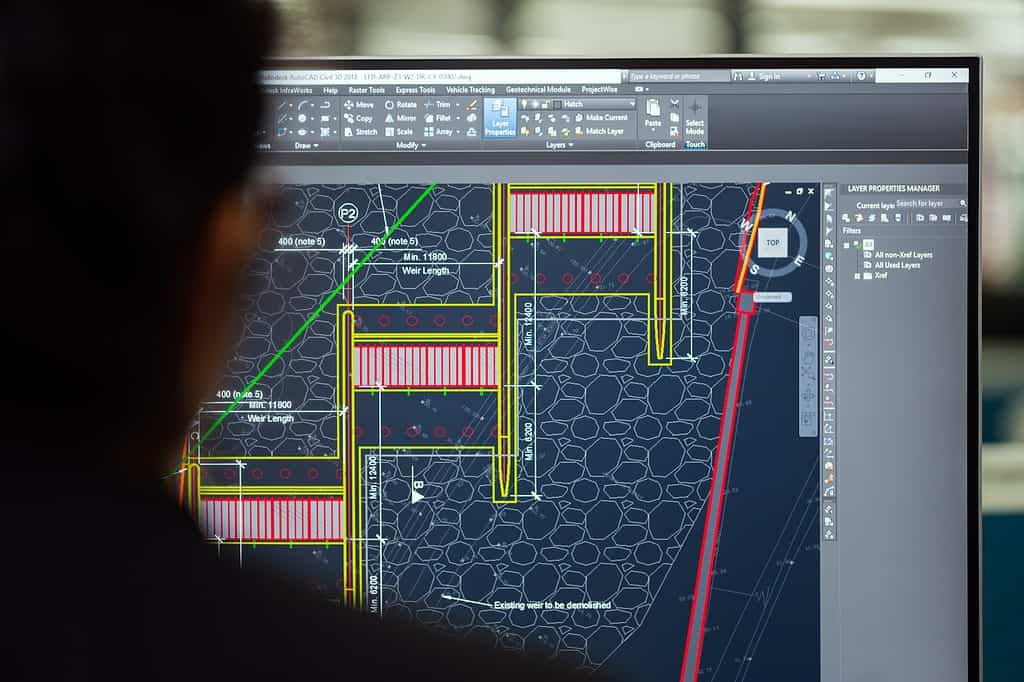
From towering skyscrapers to the humblest of homes, the structures we build are only as strong as the engineering that underpins them. That’s where structural engineers come in. They are the unsung heroes of the construction world, responsible for ensuring that the buildings we inhabit are safe, functional, and aesthetically pleasing.
Structural engineers are a type of civil engineers that oversee the structural integrity of our bridges, buildings, and other infrastructure. They calculate and draw, create structural models, review the work of other engineers, write reports and evaluations, and ensure that constructions have a good enough structure.
Simply put, they’re what makes everything stand safe and solid, without any problems or errors.
In this article, we delve into the world of structural engineering, exploring what they do, how they differ from other professionals in the industry, and what their jobs entail.
What Does a Structural Engineer Do? We asked the experts

So, what exactly does a structural engineer do? At its core, structural engineering is all about designing structures that can withstand the forces of nature and human use. From the weight of the materials used in construction to the stresses and strains imposed by wind, earthquakes, and other environmental factors, structural engineers must consider a wide range of variables in their work.
They use their knowledge of physics and mathematics to create structures that are both strong and aesthetically pleasing. They deal with the design, construction, and maintenance of the buildings we see around us.
“Structural engineering is the art of molding materials we don’t wholly understand, into shapes we can’t fully analyze, so as to withstand forces we can’t really assess, in such a way that the community at large has no reason to suspect the extent of our ignorance,” says James E. Amrhein from the Masonry Institute of America (now retired), who is a legend in his field and the author of over 20 books on structural engineering.
There are many different types of engineers, and civil engineers are one of the key professionals in the modern world.
Civil engineers conceive, design, build, operate, manage, maintain, and upgrade all infrastructure projects. Everything ranging from roads and railroads to skyscrapers, tunnels, bridges, and dams is under their supervision.
Structural engineers are a subtype of civil engineers. In particular, structural engineers are responsible for the structural aspects. They make sure that the structure’s design and materials are right for the task, and they analyze and deploy the load-bearing designs.
This means that the primary focus of a structural engineer is the stability and strength of a structure. They analyze the forces that act on a building or other infrastructure and determine the size, shape, and placement of structural elements like beams, columns, and foundations to ensure that they can support the weight and withstand external forces like wind, earthquakes, or floods. They operate within the laws of physics and do a great deal of math and physical modeling.
They also evaluate the environmental impact of a structure, ensuring that it is built in a way that minimizes its carbon footprint and energy consumption. In practice, structural engineers are responsible for making efficient use of funds.
“Every project has a structure to support “something,” and that “something” varies quite a bit per project. The first step is to gather all the information on what I’m designing. Next, I consider all the loads and select a structural system. The challenge is to then figure out how to create a set of drawings that will describe the project accurately to someone who knows nothing about it!” says Mark McKinney, PE.

The job of a structural engineer typically involves a combination of office work and on-site visits. They may spend much of their time analyzing data and creating detailed reports, but they also need to be able to visit construction sites to oversee the implementation of their designs and ensure that the construction meets the required standards. They may work on projects of varying sizes, from small residential homes to massive skyscrapers and bridges.
In modern times, a lot of the work is done in front of a computer. Structural engineers work with specialized software, ensuring that structures can withstand the stress and pressure imposed by use and the environment. They input building and environment parameters and calculate things such as stability, strength and rigidity, to make sure the right materials and structure are used for each project.
However, even though software is now an integral part of the job, structural engineers will always have to also rely on their training.
“Take the time to just look at your overall design and see if all of the steel sizes seem to make sense on a gut level. You don’t need to do hand calculations on every beam, but at least look to see if anything seems odd. Is there a relatively light beam in the middle of a bunch of heavier steel? Is there a heavy beam in the middle of a lot of lighter sections? Maybe there’s a reason and maybe there is an error in the load inputs of your design program. You will develop a sixth sense about this over your career if you regularly step back and take in your whole design from time to time,” says Rob McElroy, a structural engineer from Alabama with nearly 40 years of experience.
History of structural engineering
Structural engineering may sound modern, but it’s an ancient field of work.
The Egyptian sage Imhotep is one of the first structural engineers to undertake a massive project, and he’s also one of the first (if not the first) engineers in history to be known by name. Some 4,700 years ago, he undertook the enormous work of constructing a pyramid for Pharaoh Djoser. Pyramids are inherently stable through their geometry, but it was still a gargantuan project.
Other ancient cultures also had their own major engineering projects, but none quite like the Romans. The Romans built over 400,000 km of roads including 29 highways that lead to the city of Rome. The city of Rome alone had 11 aqueducts, and wherever the Romans went, they built — and built big. In addition to stunning buildings like the Colosseum, the Roman engineers built several massive projects, including aqueducts that are used to this day (with some repairs).

Despite their limited understanding of materials and engineering and physics, Roman engineers built a lot, and in many ways, their level was not surpassed for centuries. But starting in the Renaissance, plenty of brilliant minds dedicated effort to structural engineering.
Leonardo da Vinci made several important contributions to engineering, while Galileo Galilei wrote a book on why the structures of some buildings fall — becoming one of the first engineers to focus specifically on the theory of structural engineering.
Newton and Bernoulli, among other physicists, advanced our understanding of the laws of nature, and through constant, steady progress, engineers improved their skill and understanding.
Nowadays, there are over six million published academic papers that mention structural engineering, and with the advent of powerful computers, the area has grown tremendously.
The Difference Between a Structural Engineer and a Civil Engineer or Architect
| Structural Engineer | Civil Engineer |
|---|---|
| Design and analysis of structures such as buildings, bridges, and tunnels | Design and management of infrastructure projects such as roads, water supply systems, and airports |
| Typically requires a degree in civil engineering with a specialization in structural engineering | Requires a degree in civil engineering with a focus on broader aspects of infrastructure |
| Knowledge of physics, mathematics, and materials science; ability to design structures that can withstand different types of loads | Understanding of urban planning, construction methods, and environmental factors; ability to manage large-scale projects and budgets |
| Must pass the Structural Engineering exam and obtain a license from the state | Must pass the Civil Engineering exam and obtain a license from the state |
| Typically work for engineering consulting firms or construction companies | Work for government agencies, construction companies, or engineering consulting firms |
| Growing demand for specialized expertise in structural engineering, especially in earthquake-prone areas | Steady demand for civil engineering, with opportunities in both private and public sectors |
While structural engineers, architects, and civil engineers all work in the construction industry, they have distinct roles and responsibilities.
Architects are primarily focused on the aesthetics and functionality of a building. They design the overall layout, form, and appearance of a structure.
Civil engineers, on the other hand, are responsible for the design and construction of infrastructure projects like roads, bridges, and water treatment plants. They focus on the functionality of a structure, ensuring that it meets the needs of the community it serves.
Structural engineers may overlap with architects, and they are a sub-branch of civil engineering, but they have a different line of work.

The differences are not always clear cut, and because of practical constraints, it’s not that uncommon for civil engineers to do structural work or vice versa; it’s less advisable for architects to focus on hardcore engineering, but unfortunately, this also happens.
In general, however, civil engineers tend to focus on larger-scale projects such as infrastructure and transportation systems, while architects are more concerned with the overall design and aesthetics of a building.
Structural engineers, on the other hand, are more focused on the specific engineering aspects of the building or structure, as well as potential natural hazards.
How Much a Structural Engineer Earns
Structural engineers are in high demand, with a variety of job opportunities available across many different industries. Many work for architecture firms, consulting companies, or construction firms. Others may work for government agencies or in the energy sector.
Some structural engineers specialize in specific types of structures, such as bridges or high-rise buildings, while others may focus on a particular aspect of the job, such as materials testing or quality control.

Structural engineer jobs are usually well paid. The average salary for a structural engineer in the US is around $74,000 according to some estimates, and up to $90,000 according to others.
It’s not uncommon for structural engineers to go into the six digits. The pay grade can vary dramatically as you can work in a variety of settings, including construction firms, government agencies, and consulting firms.
Some structural engineers work for large corporations or engineering firms, while others are self-employed consultants. They may specialize in a particular area of structural engineering, such as bridge design, earthquake engineering, or high-rise construction. Keep in mind however that with a high salary also comes a big responsibility.
What’s it like being a structural engineer?
That’s all well and good, but what’s it like being a structural engineer? What are the day-to-day activities? Every job is different so you better have a good handle on what you can expect before committing to this career. Here are what experts in their field say about what’s it like being a structural engineer.
“I’m a structural engineer who specializes in bridges and other highway structures (signs, culverts, retaining walls, etc). I split somewhere between 30% doing inspections out in the field and 70% doing design and analysis work in the office. I’ve been doing this for over 5 years and have had my PE for over a year,” said reddit user 75footubi, adding that:
“When I first started I did mostly inspection work and report writing, with some CADD work in support of other engineers in the office. As I’ve gotten more senior, I do more design work and the fieldwork I do is usually related to performing analyses on existing structures. I haven’t used my stamp yet as that’s generally reserved for people who have at least twice as much experience as I do. I’m in a good group where I can learn from a variety of different people and I’m still learning something new at least 5 times a week.”
“Right now I’m in a field engineer position on an industrial site. It is basically a support role where you ensure that the design on the drawings is being implemented in the field. Where problems happen during construction, you’re there to provide corrections to the design and involve the design team if it is a large change. a good 3D model prevents a lot of these problems, but these can occur frequently in existing plants where you don’t have the most accurate information. So far I’ve issued maybe 25 field sketches to fix structural steel and concrete designs, some being critical issues that can make or break a structural design,” said Reddit user Duncaroos.
“I’m sure each firm is different, but I can give you my experiences. I work about 4 days a week in the office and one day in the field. My office work primarily consists of designing structural components for industrial and commercial buildings. I will start designing the building frame working from top-down and sketching most of my plans and details as I do the associated calculations. I am also responsible for drafting and detailing in AutoCAD or Revit. I typically will get handed a project and will continue working on it until complete or hit the deadline. I hand over my plans and they go through checks by my boss and a principal of the firm. Then I make redline corrections as required,” says Reddit user TOLstryk, adding that:
“When I’m in the field, my firm does structural inspections of buildings and field measurements for many renovation and shoring projects. Occasionally on smaller structural-only jobs I will also act as the project manager and do a few field visits. Once the fieldwork is done, I am back to the office to work on the associated calculations and design.”
Conclusion
Structural engineers are a vital part of the construction industry, ensuring that the buildings and infrastructure we rely on are safe, functional, efficient, and sustainable.
They play a critical role in safeguarding the stability of our built environment, using their expertise to design structures that can withstand the forces of nature and the test of time. Whether working on a small residential project or a massive infrastructure project, structural engineers are the unsung heroes of the construction industry, ensuring that our built environment is both beautiful and safe.
As cities and infrastructure continue to expand and evolve, the importance of structural engineering in modern society cannot be overstated. From towering skyscrapers and bridges to stadiums and dams, structural engineers are the masterminds behind the design and construction of the world’s most impressive structures.






